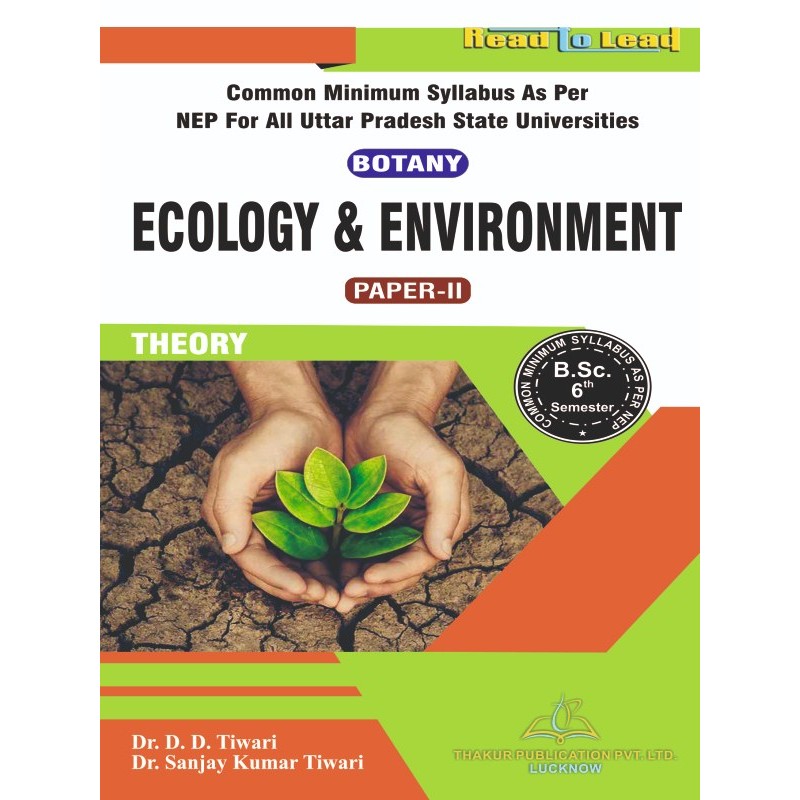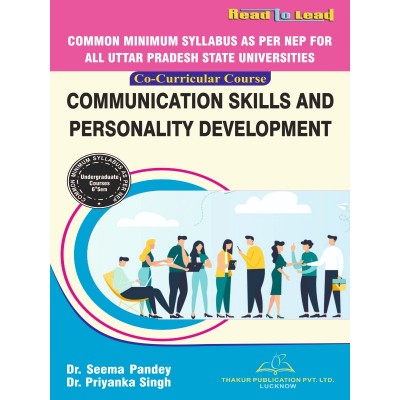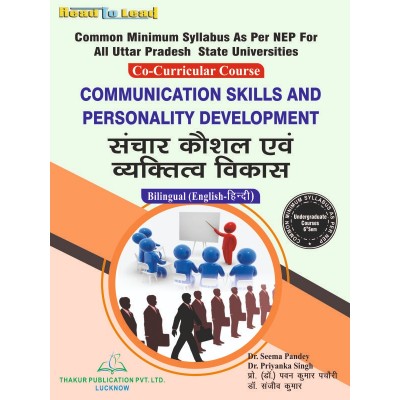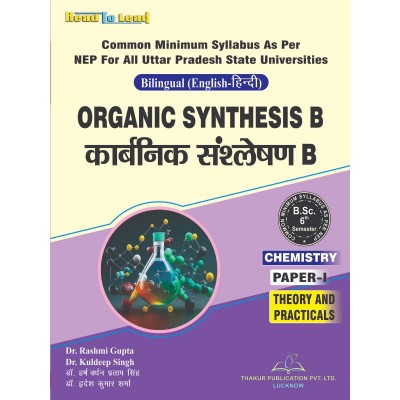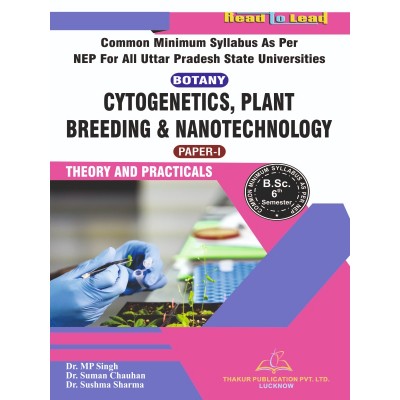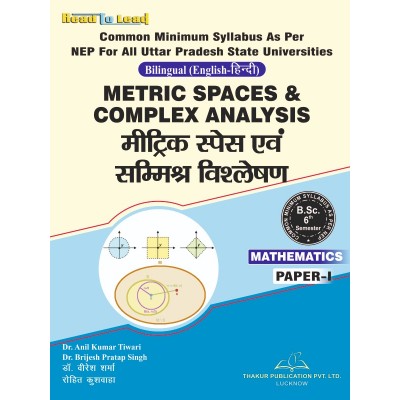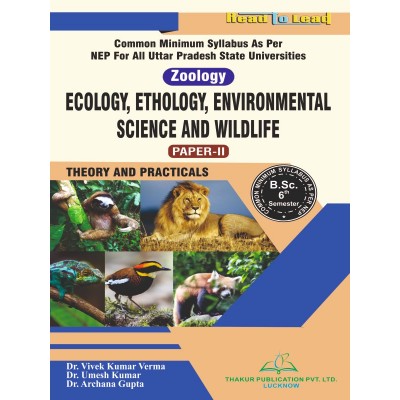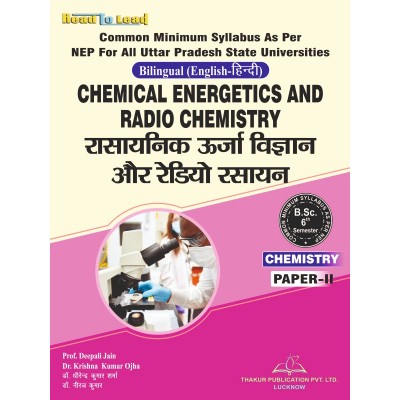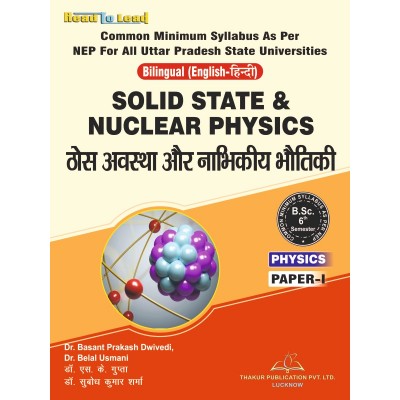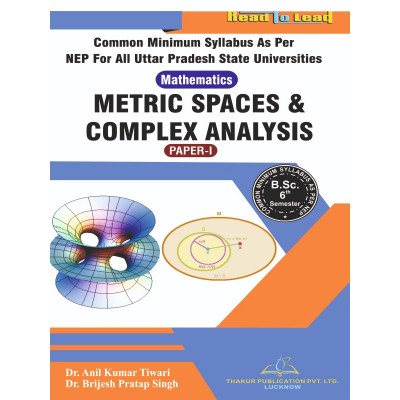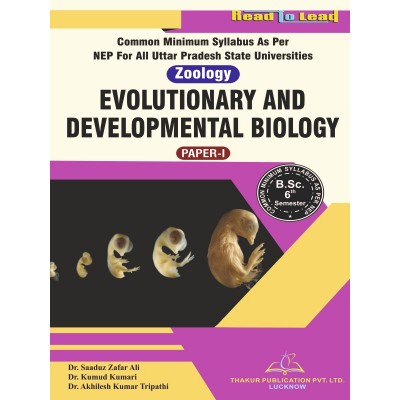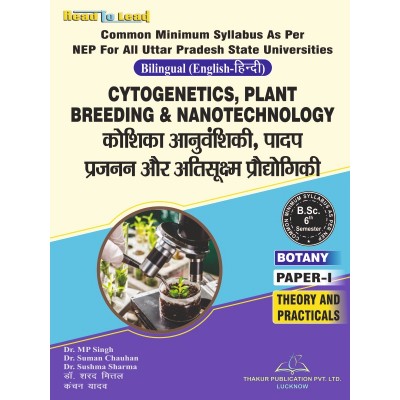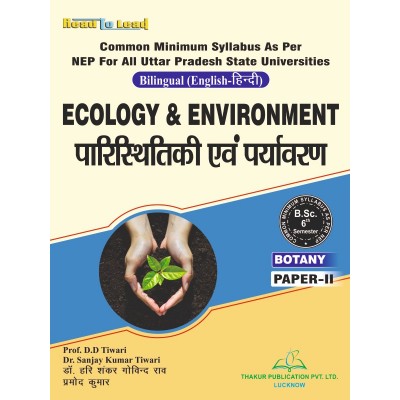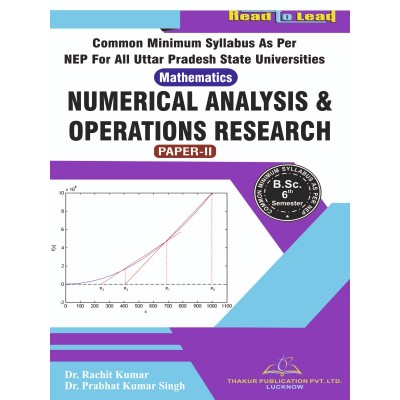(Botany) (Paper-2) ECOLOGY & ENVIRONMENT Book B.Sc 6th Sem U.P
Tax excluded
Click below to Buy E-Book Edition:
Buy Latest (Botany) (Paper-2) ECOLOGY & ENVIRONMENT Book in English Language for B.Sc 6th Semester for all U.P. State Universities Common Minimum Syllabus as per NEP. Published By Thakur Publication. Written by Experienced Authors | Fast & All India Delivery |
AUTHORS: Dr. D.D. Tiwari , Dr. Sanjay Kumar Tiwari
ISBN : 978-93-5755-455-8
Syllabus
Botany (Paper I): Cytogenetics, Plant Breeding & Nanotechnology
Course Code: B040601T
|
Unit |
Topic |
Hrs |
|
I |
Cell Biology Structure and function of cell wall, plasma membrane, ribosomes, Endoplasmic reticulum, golgi apparatus, mitochondria, chloroplast, lysosomes, peroxisomes and cell inclusions - Organisation of nucleus: nuclear envelope, nucleoplasm and nucleolus. Chromosomal nomenclature- chromatids, centromere, telomere, satellite, secondary constriction. Organization of chromosomes- Nucleic acid and histones- types and classification. Lampbrush chromosomes and polytene chromosomes- Karyotype and idiogram. Cell cycle: G0, G1, S and G2 phases – mitosis: open and closed mitosis – amitosis, meiosis. Variation in Chromosome number (Numerical aberrations)- anueploidy and Euploidy-haploidy, polyploidy- significance (Structural aberrations) - deletion, duplication, inversion and translocation. |
8 |
|
II |
Genetics Chromosome theory of inheritance, crossing over and linkage; Incomplete dominance and codominance; Interaction of Genes; Multiple alleles, Lethal alleles, Epistasis, Pleiotropy, Polygenic inheritance; Extra-nuclear Inheritance, Linkage, crossing over, Concept of sex determination and Sex chromosomes; Patterns of Sex determination in plants |
7 |
|
III |
Plant Breeding Plant introduction. Agencies of plant introduction in India, Procedure of introduction - Acclimatization – Achievements, Selection - mass selection, pure line selection and clonal selection. Genetic basis of selection methods, Hybridization: Procedure of hybridization, inter generic, inter specific, inter varietal hybridization with examples. Composite and synthetic varieties, Male sterility, Heterosis and its exploitation in plant breeding, Mutation, Molecular Breeding (use of DNA markers in plant breeding), achievements in India, Breeding for pest, pathogenic diseases and stress resistance. |
8 |
|
IV |
Biostatistics Definition, statistical methods, basic principles, variables- measurements, functions, limitations and uses of statistics. Biometry: Data, Sample, Population, random sampling, Frequency distribution- definition only, Central tendency– Arithmetic Mean, Mode and Median; Measurement of dispersion–Coefficient of variation, Standard Deviation, Standard error of Mean; Test of significance: chi- square test for goodness of fit. Computer application in biostatistics - MS Excel and SPSS |
7 |
|
V |
Plant Tissue Culture Principles, components and techniques of in vitro plant cultures, Callus cultures, Cell culture, cell suspension cultures, Embryogenesis and organogenesis, Protoplast isolation and culturing of protoplast- principle and application, regeneration of protoplasts, protoplast fusion and somatic hybridization- selection of hybrid cells, Somaclonal variation, Plant secondary metabolites production. |
8 |
|
VI |
Nanotechnology Fundamentals of nanoscale self-assembly process involved in important functional biomolecules such as Nucleic acid (DNA and RNA), Proteins, Enzymes. Cell structure and organelles, nanoscale assembly of cellular components (cell membrane and liposomes). Nanoscale assembly of microorganisms virus). Nano-particles synthesis, Biological synthesis of Nanoparticles, Advantages and applications of biologically synthesised nanomaterials. Introduction to biological nanomaterials. Biomineralisation, Magnetosomes, nano-pesticides, nano-fertilizers, nano-sensors. |
7 |
|
VII |
Artificial Intelligence in Plant Sciences Big Data Analytics, Blockchain Technology, 3-D Printing, Machine learning, Algorithms of Machine Learning, Expert systems and Fuzzy logic, Artificial Neural Networks and Genetic algorithms, Predictive Analytics, Agents and Robotics, IoT Sensors, Object Image capture & analysis; Applications of Artificial Neural Networks in Plant Science. |
8 |
|
VIII |
Introduction to Use of Digital Technologies – AI, IoT & ICT in Botany Educational software- INFLIBNET, NICNET, BRNET, internet as a knowledge repository google scholar, science direct. Resource management, weather forecasting. IoT Database management, IoT platforms, IoT Graphical user interface. IoT application development for Android Mobile phones, ICT Applications for different crops and horticulture. |
7 |
Practical Syllabus
Botany: Lab on Cytogenetics, Conservation &
Environment Management
Course Code: B040603P
|
Unit |
Topic |
Hrs |
|
I |
Cell Biology 1. Study of plant cell structure with the help of epidermal peal mount of Onion/Rhoeo/Crinum 2. Measurement of cell size by the technique of micrometry. 3. Counting cells per unit volume with the help of haemocytometer (Yeast/pollen grains) 4. Determination of mitotic index and frequency of different mitotic stages in pre-fixed root tips of Allium cepa. |
7 |
|
II |
Genetics 1. Monohybrid cross (Dominance and incomplete dominance) 2. Dihybrid cross (Dominance and incomplete dominance) 3. Gene interactions (All types of gene interactions mentioned in the syllabus)
4. Observe the genetic variations among inter and intra specific plants. 5. Demonstration of breeding techniques - Hybridisation, case studies of mutation, polyploidy, emasculation experiment. |
8 |
|
III |
Biostatistics 1. Univariate analysis of statistical data: Statistical tables, mean, mode, median, standard deviation and standard error (using seedling population /leaflet size). 2. Calculation of correlation coefficient values and finding out the probability. 3. Determination of goodness of fit in Mendellian and modified mono-and dihybrid ratios (3:1, 1:1, 9:3:3:1, 1:1:1:1, 9:7, 13:3, 15:1) by Chi-square analysis and comment on the nature of inheritance. 3. Computer application in biostatistics - MS Excel and SPSS |
7 |
|
IV |
Plant Tissue Culture 1. Familiarisation of instruments and special equipments used in the plant tissue culture experiments 2. Preparation of plant tissue culture medium, and sterilisation, Preparation of stock solutions of nutrients for MS Media. 3. Surface sterilisation of plant materials for inoculation (implantation in the medium) 4. Micropropagation of potato/tomato/ - Demonstration 5. Protoplast isolation and culturing – Demonstration |
8 |
|
V |
Ecology & Environment 1. Ecological adaptations: Hydrophytes, Xerophytes, Halophytes, Epiphytes and Parasites 2. Study of morphological adaptations of hydrophytes and xerophytes (four each). 3. Study of biotic interactions of: Stem parasite (Cuscuta), Root parasite (Orobanche) Epiphytes, Predation (Insectivorous plants). 4. Observation and study of different ecosystems mentioned in the syllabus. 5. Field visit to familiarise students with ecology of different sites |
8 |
|
VI |
Soil Formation, Properties & Conservation 1. Determination of pH of various soil and water samples (pH meter, universal indicator/Lovibond comparator and pH paper) 2. Analysis for carbonates, chlorides, nitrates, sulphates, organic matter and base deficiency from two soil samples by rapid field tests. 3. Determination of organic matter of different soil samples by Walkley & Black rapid titration method. 4. Soil Profile study 5. Soil types of India-Map |
8 |
|
VII |
Biodiversity and Phytogeography 1. Study of community structure by quadrat method and determination of (i) Minimal size of the quadrat, (ii) Frequency, density and abundance of components (to be done during excursion/field visit). 2. Marking of vegetation types of India, World & Uttar Pradesh on maps 3. Phytogeographical areas of India |
7 |
|
VIII |
Pollution & Waste Management 1. Study of instruments used to measure microclimatic variables: Soil thermometer, maximum and minimum thermometer, anemometer, psychrometer/hygrometer, rain gauge and lux meter 2. Estimation of chloride and dissolved oxygen content in water sample 3. Comparative anatomical studies of leaves form polluted and less polluted areas. 4. Measurement of dissolved O2 by azide modification of Winkler’s method. 5. Determination of dissolved oxygen of water samples from polluted and unpolluted sources. 6. Microbiological assessment of drinking water using MPN technique- water from well, river, water supply department and packaged drinking water 7. Making kitchen waste from compost/vermicompost by Enzymes/Bio decomposer/ Whey with dung.
Climate Change, Carbon Credits & Role of GIS 1. Conducting Waste Audit of your Institution -Demo 2. Green auditing of the College/University -Demo |
7 |







